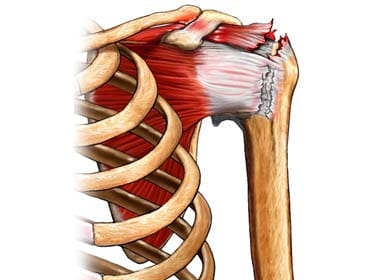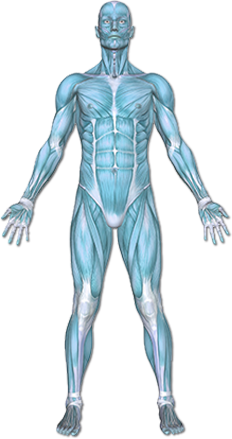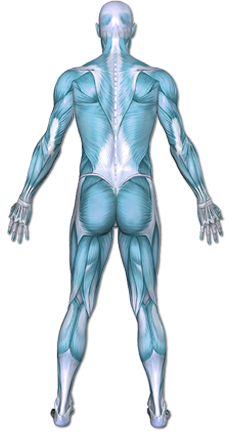Rotator Cuff Tear/ Impingement
A rotator cuff injury may include tendinitis, strain, or tear of the rotator cuff. The rotator cuff is made up of muscles and four separate tendons that fuse together to surround the shoulder joint.


Copyright © Nucleus Medical Media, Inc.
This content was created using EBSCO’s Health Library
Causes of a rotator cuff injury include:
- Direct blow to the shoulder area
- Falling on an outstretched arm
- Chronic degenerative wear and tear on the tendons:
- Arthritis may decrease the space for the tendons
- Chronic instability of the humerus may traumatize the tendons
- Repetitive overhead motion of the arm such as in:
- Swimming
- Baseball (mainly pitching)
- Tennis
This content was created using EBSCO’s Health Library
A risk factor is something that increases your chance of getting a disease or condition. Risk factors for a rotator cuff injury include:
- Age: 40 or older
- Heavy lifting
- Abnormalities of the shoulder in rotator cuff anatomy or function
- Activities that involve repetitive overhead arm motion such as throwing or work-related
- Weakened shoulder muscles from inactivity or previous injury
This content was created using EBSCO’s Health Library
- Recurrent, constant pain, particularly when reaching overhead
- Pain at night that prevents you from sleeping
- Shoulder muscle weakness, especially when lifting the arm
- Popping or clicking sounds when the shoulder is moved
- Limited range of motion in the shoulder joint
This content was created using EBSCO’s Health Library
The doctor will ask about your symptoms and medical history. A physical exam will be done. The doctor will carefully examine your shoulder. You will be asked to move your shoulder in several directions. Tests may include:
- Ultrasound
- Arthrogram
- MRI
- Arthroscopy
This content was created using EBSCO’s Health Library
The normal course of a POST-SURGICAL rotator cuff protocol has been described as having five stages: Stage 1: Immobilization
- There is a mandatory period of rest for the arm following a rotator cuff surgery. The tendons have been repaired but need to wait through the biological healing phase in order to be able to accept the strain of moving the arm. This period may last 4-6 weeks and may be intermittent with the therapist being able to do slight motions to the arm to keep the joint from getting stiff.
Stage 2: Passive motion
- During and after the immobilization phase, you’ll begin performing passive motion exercises. At first, the therapist will provide the muscle to move the arm, but over time, you’ll be educated in use of pulleys, stretch straps and table stretches to allow the joint to move while keeping the muscles fully relaxed.
Stage 3: Active-Assisted motion
- Once the shoulder has achieved full expected passive motion, and with the permission of the surgeon, your therapist will begin active-assisted motion. This type of exercise uses less than 100% of the surgical shoulder’s power to move the arm. The therapist may instruct you in pendulum exercises that employ gravity and momentum. Self-ranging exercises use the uninvolved arm to move the involved arm, either against the weight of gravity or lying down so that the weight of gravity is minimalized. The surgical arm’s responsibility will slowly increase up to 100% of the weight of the arm. Then, you’ll be ready for active motion.
Stage 4: Active motion
- The active motion phase begins when the arm is able to carry its own weight against gravity but is not yet ready to lift, push or pull objects. During this phase, your therapist will demonstrate safe motion patterns of the shoulder and shoulder blade. They will monitor the coordination of movement between the muscles to check for specific weakness that could put strain on the repair. Once you can achieve full expected active range of motion against the weight of gravity, and with your physician’s approval, you’ll be ready to add weight.
Stage 5: Strengthening
- The strengthening program may start out slowly. Be patient! The muscles are relearning how to work together so inflammation of the tendons and bursae are still a risk in this phase. Your therapist will recommend exercises that you can do at home in order to improve the arm’s tolerance for strength and to reduce the strain on the arm when you come into therapy. Over time, the therapist will demonstrate ways that you can safely use the arm for pushing up from a chair, pulling a door open, reaching into a cabinet and other activities of daily living.
NON-SURGICAL rotator cuff tear
- In the shoulder that does not require surgery it is important to determine the cause of the pain and inflammation and work to reduce both. The therapist will likely recommend home modality use to reduce symptoms and the physician may recommend oral or injectable anti-inflammatory medications. Once the arm has responded well to these measures, it is time to begin lightly strengthening the uninvolved muscles so they can support the injured ones. Shoulder blade mobility can play a large role in reducing the pinch of tendons between the acromion (front part of the shoulder blade) and the top of the humerus (the long arm bone). By improving the mechanics of motion between the shoulder blade and the humerus, the therapist can help you reduce pain, inflammation, and the potential for more tearing.
This content was created using EBSCO’s Health Library
To reduce your chances of getting a rotator cuff injury:
- Avoid overhead repetitive motion
- Limit duration of work that involves
- Moving hands above shoulders
- Using shoulder in extreme outward rotation
- Vibrating tools
- Avoid heavy lifting
- Exercise regularly to strengthen the muscles around the shoulder joint
This content was created using EBSCO’s Health Library
This content was created using EBSCO’s Health Library
RESOURCES:
American Academy of Orthopaedic Surgeons http://www.aaos.org The American Orthopaedic Society for Sports Medicine http://www.sportsmed.org
CANADIAN RESOURCES:
Canadian Orthopaedic Association http://www.coa-aco.org The University of British Columbia Department of Orthopaedics http://orthopaedics.med.ubc.ca
REFERENCES:
- Castricini R, et al. Platelet-rich plasma augmentation for arthroscopic rotator cuff repair: a randomized controlled trial. Am J Sports Med. 2011 Feb;39(2):258-65.
- Deu RS. Common Sports Injuries: Upper Extremity Injuries. Clin Fam Pract. 2005 Jun; 7(2); 249-265.
- Rotator cuff tear. EBSCO DynaMed website. Available at: https://dynamed.ebscohost.com. Updated May 28, 2012. Accessed October 23, 2012.
- Smith MA, Smith WT. Rotator cuff tears: an overview. Orthop Nurs. 2010;29(5):319-322
- 10/26/2010 DynaMed’s Systematic Literature Surveillance https://dynamed.ebscohost.com/about/about-us: Massey T, Derry S, Moore R, McQuay H. Topical NSAIDs for acute pain in adults. Cochrane Database Syst Rev. 2010;(6):CD007402.
- Bishay V, Gallo RA. The evaluation and treatment of rotator cuff pathology. Prim Care. 2013 Dec;40(4):889-910, viii
- Contreras F, Brown HC, Marx RG. Predictors of success of corticosteroid injection for the management of rotator cuff disease. HSS J. 2013 Feb;9(1):2-5.
- Cuff DJ, Pupello DR. Prospective randomized study of arthroscopic rotator cuff repair using an early versus delayed postoperative physical therapy protocol. J Shoulder Elbow Surg. 2012 Nov;21(11):1450-5.
- Downie BK, Miller BS. Treatment of rotator cuff tears in older individuals: a systematic review. J Shoulder Elbow Surg. 2012 Sep;21(9):1255-61.
- Harris JD, Pedroza A, Jones GL; MOON (Multicenter Orthopedic Outcomes Network) Shoulder Group. Predictors of pain and function in patients with symptomatic, atraumatic full-thickness rotator cuff tears: a time-zero analysis of a prospective patient cohort enrolled in a structured physical therapy program. Am J Sports Med. 2012 Feb;40(2):359-66.
- Itoi E. Rotator cuff tear: physical examination and conservative treatment. J Orthop Sci. 2013 Mar;18(2):197-204.
- Kuhn JE, Dunn WR, Sanders R, An Q, Baumgarten KM, Bishop JY, Brophy RH, Carey JL, Holloway BG, Jones GL, Ma CB, Marx RG, McCarty EC, Poddar SK, Smith MV, Spencer EE, Vidal AF, Wolf BR, Wright RW; MOON Shoulder Group. Effectiveness of physical therapy in treating atraumatic full-thickness rotator cuff tears: A multicenter prospective cohort study. J Shoulder Elbow Surg. 2013 Oct;22(10):1371-9.
- Lansdown DA, Feeley BT. Evaluation and treatment of rotator cuff tears. Phys Sportsmed. 2012 May;40(2):73-86.
- Pegreffi F, Paladini P, Campi F, Porcellini G. Conservative management of rotator cuff tear. Sports Med Arthrosc. 2011 Dec;19(4):348-53.
- Pill SG, Phillips J, Kissenberth MJ, Hawkins RJ. Decision making in massive rotator cuff tears. Instr Course Lect. 2012;61:97-111.
This content was created using EBSCO’s Health Library


